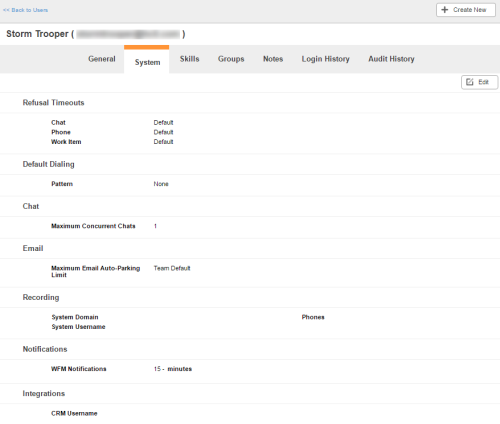Required security profile permissions: Users View.
The user profile System tab page displays information about the user's dialing pattern and settings per media type.
For more information, see Users Overview.
Buttons
Refusal Timeouts
- Chat
- The number of seconds the user can be idle in an active chat before the chat times out and transfers to another user. If blank, the profile inherits the business unit default.
- Phone
- The number of seconds the user can be idle in an active call before the call times out and transfers to another user. If blank, the profile inherits the business unit default.
- Work Item
- The number of seconds the user can be idle in an active work item before the work item times out and transfers to another user. If blank, the profile inherits the business unit default.
Default Dialing
- Pattern
- The default dialing pattern assigned to the user. A dialing pattern specifies the way each call is dialed. For instance, a dialing pattern can specify that each call must begin with '1'. Agents do not need to a dial a '1' before every call, because the system prepends it to the number dialed.
Chat
- Maximum Concurrent Chats
- The maximum number of chats the user may engage in simultaneously. It is either the Team Default, or the maximum number of chats allowed for the team to which the user belongs, or a number between 1 and 8.
- Maximum Email Auto-Parking Limit
- The maximum number of emails the user may contain in the inbox at one time. It is either the Team Default, or the maximum number of emails allowed for the team to which the user belongs, or a number between 1 and 25.
Recording
- System Domain
- Available only in an inContact WFO-enabled environment. Allows you to add the domain associated with the System Username field to the user's account.
- System Username
- Available only in an inContact WFO-enabled environment. Allows you to add a Windows username to the user's account (that is, the name with which the user logs in to your network). This field is mandatory if your organization uses inContact Screen Recording. inContact WFO uses it to locate the user's desktop via the screen recording client. Each user must have a unique system username, regardless of Windows domain, and they must log in to their desktop PC with that system username. For example, if your organization has two Sally Smiths, they cannot both have "ssmith" as their Windows username even if they are on separate Windows domains.
- Phones
-
Only visible if your system includes inContact WFO and if the user has been assigned to a WFO-enabled team. In hosted systems, this value is the phone ID, associated with the user in the inContact PBX, that will be recorded. In hybrid systems, you can add multiple logins, extensions, or both associated with the agent. For fixed-seating environments, the values should be the physical telephone extensions. For free-seating environments, the values should be the agent numbers or logins associated with the user in your PBX. The way you enter the information typically varies depending on your integration:
- Avaya — phone extension or agent login (4-7 digits, such as 8765 or 24689)
- Cisco — phone extension (4-7 digits) or phone MAC address (alphanumeric 15 digits)
- ShoreTel — phone extension (typically 4 digits)
Consider the following when you add information to the Phones field:
- You cannot assign an extension to more than one user. For example, extension 1234 cannot be assigned to Sally Smith and Jenny Jones, even if they sit at the same extension on different shifts.
- You can assign multiple extensions to the same user. For example, Sally Smith may take incoming calls on extension 1234 and make outbound calls on extension 4321.
Notifications
- WFM Notifications Minutes
- The number of minutes before an event in the agent schedule occurs that Agent notifies the agent of the upcoming event. You can set this feature to Off, or you can configure the notification to occur 5, 10, or 15 minutes before the event.
Integrations
- CRM Username
- Only visible if your system includes inContact WFO and if the user has been assigned to a WFO-enabled team. It allows you to associate the username from your CRM system with this user’s account. This may be useful for reference purposes, or if you have a custom API (application programming interface) integration to your CRM.
